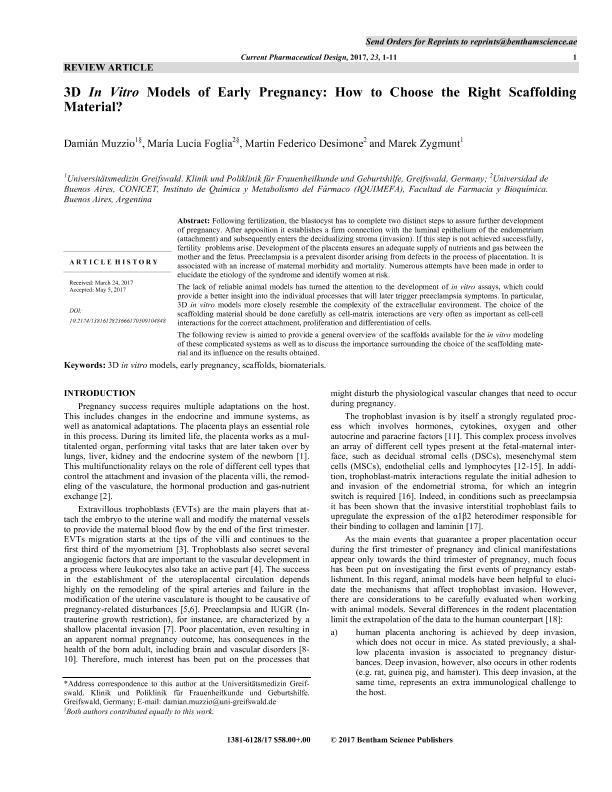Mostrar el registro sencillo del ítem
dc.contributor.author
Muzzio, Damián
dc.contributor.author
Foglia, María Lucía

dc.contributor.author
Desimone, Martín Federico

dc.contributor.author
Zygmunt, Marek

dc.date.available
2018-03-28T16:37:49Z
dc.date.issued
2017-07
dc.identifier.citation
Muzzio, Damián; Foglia, María Lucía; Desimone, Martín Federico; Zygmunt, Marek; 3D in vitro models of early pregnancy: How to choose the right scaffolding material?; Bentham Science Publishers; Current Pharmaceutical Design; 23; 24; 7-2017; 3603-3613
dc.identifier.issn
1381-6128
dc.identifier.uri
http://hdl.handle.net/11336/40368
dc.description.abstract
Following fertilization, the blastocyst has to complete two distinct steps to assure further development of pregnancy. After apposition it establishes a firm connection with the luminal epithelium of the endometrium (attachment) and subsequently enters the decidualizing stroma (invasion). If this step is not achieved successfully, fertility problems arise. Development of the placenta ensures an adequate supply of nutrients and gas between the mother and the fetus. Preeclampsia is a prevalent disorder arising from defects in the process of placentation. It is associated with an increase of maternal morbidity and mortality. Numerous attempts have been made in order to elucidate the etiology of the syndrome and identify women at risk. The lack of reliable animal models has turned the attention to the development of in vitro assays, which could provide a better insight into the individual processes that will later trigger preeclampsia symptoms. In particular, 3D in vitro models more closely resemble the complexity of the extracellular environment. The choice of the scaffolding material should be done carefully as cell-matrix interactions are very often as important as cell-cell interactions for the correct attachment, proliferation and differentiation of cells. The following review is aimed to provide a general overview of the scaffolds available for the in vitro modeling of these complicated systems as well as to discuss the importance surrounding the choice of the scaffolding material and its influence on the results obtained.
dc.format
application/pdf
dc.language.iso
eng
dc.publisher
Bentham Science Publishers

dc.rights
info:eu-repo/semantics/openAccess
dc.rights.uri
https://creativecommons.org/licenses/by-nc-sa/2.5/ar/
dc.subject
3d in Vitro Models
dc.subject
Biomaterials
dc.subject
Decidualizing Stroma
dc.subject
Early Pregnancy
dc.subject
Endometrium
dc.subject
Scaffolds
dc.subject.classification
Otras Biotecnologías de la Salud

dc.subject.classification
Biotecnología de la Salud

dc.subject.classification
CIENCIAS MÉDICAS Y DE LA SALUD

dc.title
3D in vitro models of early pregnancy: How to choose the right scaffolding material?
dc.type
info:eu-repo/semantics/article
dc.type
info:ar-repo/semantics/artículo
dc.type
info:eu-repo/semantics/publishedVersion
dc.date.updated
2018-03-28T14:10:39Z
dc.journal.volume
23
dc.journal.number
24
dc.journal.pagination
3603-3613
dc.journal.pais
Estados Unidos

dc.journal.ciudad
Oak Park
dc.description.fil
Fil: Muzzio, Damián. Universitätsmedizin Greifswald; Alemania
dc.description.fil
Fil: Foglia, María Lucía. Consejo Nacional de Investigaciones Científicas y Técnicas. Oficina de Coordinación Administrativa Houssay. Instituto de Química y Metabolismo del Fármaco. Universidad de Buenos Aires. Facultad de Farmacia y Bioquímica. Instituto de Química y Metabolismo del Fármaco; Argentina
dc.description.fil
Fil: Desimone, Martín Federico. Consejo Nacional de Investigaciones Científicas y Técnicas. Oficina de Coordinación Administrativa Houssay. Instituto de Química y Metabolismo del Fármaco. Universidad de Buenos Aires. Facultad de Farmacia y Bioquímica. Instituto de Química y Metabolismo del Fármaco; Argentina
dc.description.fil
Fil: Zygmunt, Marek. Universitätsmedizin Greifswald; Alemania
dc.journal.title
Current Pharmaceutical Design

dc.relation.alternativeid
info:eu-repo/semantics/altIdentifier/url/http://www.eurekaselect.com/152275/article
dc.relation.alternativeid
info:eu-repo/semantics/altIdentifier/doi/http://dx.doi.org/10.2174/1381612823666170509104848
Archivos asociados
